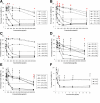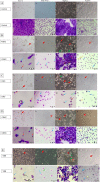Cytotoxicity effect of degraded and undegraded kappa and iota carrageenan in human intestine and liver cell lines
- PMID: 25519220
- PMCID: PMC4320596
- DOI: 10.1186/1472-6882-14-508
Cytotoxicity effect of degraded and undegraded kappa and iota carrageenan in human intestine and liver cell lines
Abstract
Background: Carrageenan is a linear sulphated polysaccharide extracted from red seaweed of the Rhodophyceae family. It has broad spectrum of applications in biomedical and biopharmaceutical field. In this study, we determined the cytotoxicity of degraded and undegraded carrageenan in human intestine (Caco-2; cancer and FHs 74 Int; normal) and liver (HepG2; cancer and Fa2N-4; normal) cell lines.
Methods: Food grade k-carrageenan (FGKC), dried sheet k-carrageenan (DKC), commercial grade k-carrageenan (CGKC), food grade i-carrageenan (FGIC) and commercial grade i-carrageenan (CGIC) were dissolved in hydrochloric acid and water to prepare degraded and undegraded carrageenan, respectively. Carrageenan at the concentration range of 62.5 - 2000.0 μg mL(-1) was used in the study. MTT assay was used to determine the cell viability while the mode of cell death was determined by May-Grunwald Giemsa (MGG) staining, acridine orange-ethidium bromide (AO/EtBr) staining, agarose gel electrophoresis and gene expression analysis.
Results: Degraded FGKC, DKC and CGKC showed IC50 in 24, 48 and 72 hours treated Caco-2, FHs 74 Int, HepG2 and Fa2N-4 cell lines as tested by MTT assay. Degraded FGIC and CGIC only showed its toxicity in Fa2N-4 cells. The characteristics of apoptosis were demonstrated in degraded k-carrageenan treated Caco-2, FHs 74 Int, HepG2 and Fa2N-4 cells after MGG staining. When Caco-2 and HepG2 cells were undergone AO/EtBr staining, chromatin condensation and nuclear fragmentation were clearly seen under the microscope. However, DNA ladder was only found in HepG2 cells after gel electrophoresis analysis. Degraded k-carrageenan also inactivated PCNA, Ki-67 and survivin gene in HepG2. On the other hand, undegraded FGKC, DKC, CGKC, FGIC and CGIC treated cells showed no cytotoxic effect after analyzed by the same analyses as in degraded carrageenan.
Conclusion: Degraded k-carrageenan inhibited cell proliferation in Caco-2, FHs 74 Int, HepG2 and Fa2N-4 cell lines and the anti-proliferative effect was related to apoptosis together with inactivation of cell proliferating genes as determined by morphological observation and molecular analysis. However, no cytotoxic effect was found in undegraded carrageenan towards normal and cancer intestine and liver cell lines.
Figures








References
-
- Meeting Joint FAO/WHO Expert Committee on Food Additives, Organization WH . Compendium of Food Additive Specifications: Addendum 9. 2001.
-
- Necas J, Bartosikova L. Carrageenan: a review. Vet Med. 2013;58:187–205.
Pre-publication history
-
- The pre-publication history for this paper can be accessed here:http://www.biomedcentral.com/1472-6882/14/508/prepub
Publication types
MeSH terms
Substances
LinkOut - more resources
Full Text Sources
Other Literature Sources
Miscellaneous

